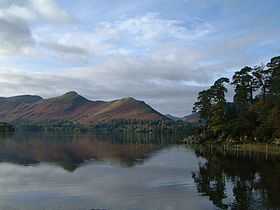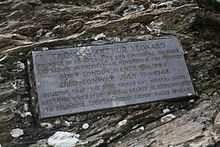Catbells
| Catbells | |
|---|---|
 The classic view of Catbells from near Friars Crag on the opposite side of Derwent Water | |
| Elevation | 451 m (1,480 ft) |
| Prominence | 86 m (282 ft) |
| Parent peak | Dale Head |
| Listing | Wainwright |
| Location | |
 Catbells Location in Lake District, UK | |
| Location | Cumbria, England |
| Range | Lake District, North Western Fells |
| OS grid | NY244199 |
| Coordinates | 54°34′07″N 3°10′15″W / 54.56865°N 3.17083°WCoordinates: 54°34′07″N 3°10′15″W / 54.56865°N 3.17083°W |
| Topo map | OS Landrangers 89, 90, Explorer OL4 |
Catbells is a fell in the English Lake District in the county of Cumbria. It has a modest height of 451 metres (1,480 ft) but despite this it is one of the most popular fells in the area. It is situated on the western shore of Derwent Water within 3 miles (5 km) of the busy tourist town of Keswick. Its distinctive shape catches the attention of many visitors to the Lakes who feel compelled to climb to the summit after seeing it from the viewpoint of Friars Crag on the opposite side of Derwent Water. Renowned Lake District writer and walker Alfred Wainwright acknowledges the popularity of Catbells among fellwalkers of all ability by saying:
- "It is one of the great favourites, a family fell where grandmothers and infants can climb the heights together, a place beloved. Its popularity is well deserved, its shapely topknott attracts the eye offering a steep but obviously simple scramble."
Name
The fell's unusual name may well have come from a distortion of "Cat Bields" meaning shelter of the wild cat, although this is not certain. The fell's name is sometimes written as Cat Bells and is so printed on some maps.
Topography
Catbells is the last fell on the ridge separating Derwent Water from the Newlands valley. It rises due south from Hawse End, reaching the summit in two distinct steps. The lower top is named Skelgill Bank. Beyond the summit of Catbells is the steep sided depression of Hause Gate, before the ridge broadens and twists south westward to Maiden Moor.
Geology
The Catbells ridge is an example of the Buttermere Formation, an olistostrome of disrupted, sheared and folded mudstone, siltstone and sandstone.[1]
Ascents

Nearly all ascents of Catbells start from Hawse End at the foot of the northern ridge; there is car parking here but the spaces soon get taken on busy summer days. Hawse End is also served by the Derwent Water Motor Launch and this enables visitors to Keswick to combine a sail on the lake with an ascent of the fell. Many walkers who reach the top of Catbells return to their starting point after admiring the view, however, strong walkers can continue along the ridge to take in the fells of Maiden Moor, High Spy, Dale Head, Hindscarth and Robinson to give a horseshoe walk which ends in the Newlands valley close to Hawse End.
Summit
The summit is all rock with many loose stones lying amid the small outcrops. The view from the top of Catbells gives a fine panorama which is dominated by the aerial view of Derwentwater. Bassenthwaite Lake, the Newlands Valley, Skiddaw and Keswick all show well to the north, while the view south has a fine vista of Borrowdale.

Mining
Although Catbells is renowned as a "family fell" it does have some dangers especially from the disused lead mines on its slopes. The Yewthwaite mine, which is on the western side of the fell has extensive spoil heaps and shafts. Many of the shafts were previously open and dangerous but most have now been blocked off. The Brandlehow and Old Brandley Mine worked a lode for lead ore on the Derwent Water (eastern) side of the fell. All three mines ceased production in the 1890s. On the lower slopes of the fell above Derwent Water stands Brackenburn Lodge, now holiday accommodation but formerly the home of Hugh Walpole who wrote the Herries series of books when he lived here from 1924 to his death in 1941.
Memorials

On the lower slopes of the fell is a memorial stone to Thomas Arthur Leonard (1864-1948), a pioneer of outdoor holidays for working people who founded the Co-operative Holidays Association and the Holiday Fellowship.
Notes
- ↑ British Geological Survey: 1:50,000 series maps, England & Wales Sheet 29: BGS (1999)
References
- A Pictorial Guide to the Lakeland Fells, The North Western Fells, Alfred Wainwright ISBN ISBN 0-7112-2459-5
- The Mountains of England and Wales, John and Anne Nuttall, ISBN 1-85284-037-4
- Catbells Pale Ale
| ||||||||||||||||||||||||||||||